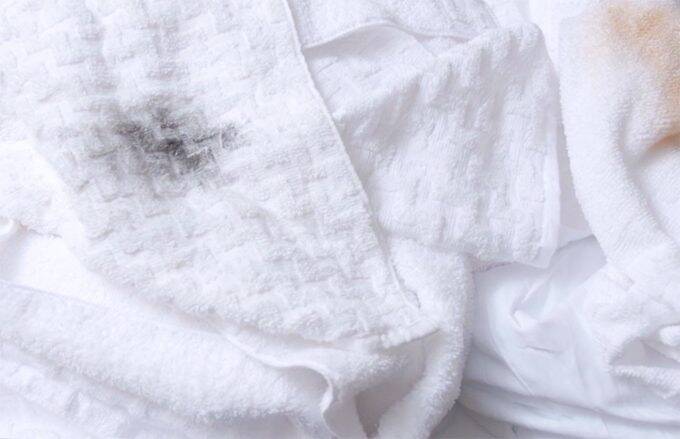August 28, 2023
The Art of Stain Removal: 7 Reasons Stubborn Stains Stick Around

Stain removal in hotels and hospitals can often be more of an art form than a standard procedure. Successfully removing stains from sheets & towels requires skill, experience, and patience. But with the right strategy, you can save thousands of dollars by recovering stained linen that otherwise would need to be replaced.
To understand the best approach to staining, it’s important to understand what makes a stain so difficult to remove in the first place.
7 Reasons Stains Stick Around
Laundry technician examining sheets for damage
1.) Not Separating Stained Linen
Housekeeping and laundry staff should always be on the lookout for stained linen in order to handle appropriately. If an item is heavily soiled, separating it from the normal soiled goods prior to laundering is recommended. Heavily soiled linen can challenge the effectiveness of the normal wash process and potentially allow the staining substance to spread to other items, a costly problem we call redeposition. Stained linen will require special treatment and should be laundered separately using an appropriate reclaim type process (see #4).
2.) Time
Another challenge in fighting stains is time. The longer a stained sheet or towel sits, the more difficult stain removal becomes. This is especially true today in hospitality, with daily housekeeping largely a thing of the past. The sooner soiled linen can be recovered, the quicker it will be laundered which increases the chances for soils to be removed.
3.) Lack of Spotting
Spotting, or spot treatment, can be an effective first step in treating a variety of stains. Without it, many stains will remain even after washing. Basic spotting can often be done with detergent, while others will respond better to laundry chemicals such as hydrogen peroxide, citrus-based solvents, or commercial spotting compounds.
Be sure to review the stain type carefully and select the proper spotting agent. Improper use of a chemical spotting agent may not have any impact on the stain or possibly even create further linen damage. Some spotting agents are corrosive and should not be allowed to sit on products for an extended period of time as this can degrade the cotton. Your chemical supplier can provide literature on effective spot treatments. Experienced laundry operators are also a key when it comes to spotting stains.
4.) Using a Standard Wash Cycle
When dealing with heavily stained items, your standard wash cycle is not aggressive enough to tackle stains. If the stains were not removed in the initial wash, it is not likely they will be removed in a second wash using the same process, especially if the stained item was dried. Creating a more aggressive wash cycle can often be beneficial.
Depending on the stain, using an extended flush, adding a pretreatment chemical in the flush, increasing mechanical action (reduced load size), wash temperatures, cycle times, chemical concentrations, (using an elevated amount of chlorine bleach in the bleach bath, higher pH, more sudsing), and/or adding rinses can be effective. Consult with your laundry chemical supplier before making any changes to avoid further damage.
When treating stains, load size should be maintained at 80% or less of the rated capacity of the washer.
5.) Load Size
To maximize soil/stain removal, it is recommended that load size is maintained at 80% of the rated capacity of the washer. Overloading washers will minimize the efficiency of the wash process and create higher staining levels. Note with a stain reclaim process, load sizes may be reduced to less than 80% to allow for higher mechanical action.
6.) Heat
Heat can cause stains to set, making them virtually impossible to remove. When washing stained items, be sure to use a cold or warm water flush in the initial step of the wash process (we typically recommend no higher than 100F). This step can be 1-2 minutes in length. After washing, do not dry items unless you are certain the stain has been removed. When stains remain, repeating the wash process using a stain reclaim and/or stain spotting agents can often help lift stubborn stains.
7.) One Size Fits All Treatment
Not all stains are created equal. Some stains will easily come off in a standard wash, while others will require intensive spotting or pre-soaks. Being able to identify the type of stain and treat accordingly will drastically increase your chances of success.
There’s a reason 70% of hotel laundry staff identify removing stains as their biggest challenge. With a wide range of stain types and countless treatment options, it can seem like an uphill battle.
We encourage laundry managers to partner with their chemical suppliers to identify the most effective treatments for their most common stains. We also recommend creating posters or flyers for laundry staff with photos of stain types and detailed instructions on how to treat them. Chemical suppliers often have literature available that can help with this process.
With proper knowledge and techniques, your laundry can drastically reduce linen loss and the costs associated with it. For further questions or support, please don’t hesitate to contact our laundry experts today.
Related Content

5 Tips Steps to Tackle Cosmetic Stains on Your Hotel’s Linens
Stains are an unavoidable, everyday issue for hoteliers. Check out this helpful article specifically addressing how to deal with cosmetic and other common stains.

Wallcoverings: They’re sticking around!
Wallcoverings have a big impact on a property’s look and functional capabilities. From lobbies to waiting rooms, to bathrooms and guestrooms, wallcoverings can brand your space, and create an environment that speaks to your guests.

Sunbrella Assure fabric is tough on stains, but easy on the environment.
Standard Textile Interiors is excited to partner with Sunbrella on a new, sustainability-focused innovation — Sunbrella Assure, a fluorine-free textile that delivers water repellency, stain resistance, and enhanced durability. Offered in three exclusive patterns for Standard Textile Interiors that actively contribute to improving the environment.